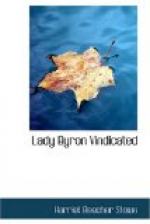Nine years after her death, when it was fully understood that no story on her side or that of her friends was to be forthcoming, then her calumniators raked out from the ashes of her husband’s sepulchre all his bitter charges, to state them over in even stronger and more indecent forms.
There seems to be reason to think that the materials supplied by Lord Byron for such a campaign yet exist in society.
To ‘The Noctes’ of November 1824, there is the following note apropos to a discussion of the Byron question:—
’Byron’s Memoirs, given by him to Moore, were burned, as everybody knows. But, before this, Moore had lent them to several persons. Mrs. Home Purvis, afterwards Viscountess of Canterbury, is known to have sat up all one night, in which, aided by her daughter, she had a copy made. I have the strongest reason for believing that one other person made a copy; for the description of the first twenty-four hours after the marriage ceremonial has been in my hands. Not until after the death of Lady Byron, and Hobhouse, who was the poet’s literary executor, can the poet’s Autobiography see the light; but I am certain it will be published.’
Thus speaks Mackenzie in a note to a volume of ‘The Noctes,’ published in America in 1854. Lady Byron died in 1860.
Nine years after Lady Byron’s death, when it was ascertained that her story was not to see the light, when there were no means of judging her character by her own writings, commenced a well-planned set of operations to turn the public attention once more to Lord Byron, and to represent him as an injured man, whose testimony had been unjustly suppressed.
It was quite possible, supposing copies of the Autobiography to exist, that this might occasion a call from the generation of to-day, in answer to which the suppressed work might appear. This was a rather delicate operation to commence; but the instrument was not wanting. It was necessary that the subject should be first opened by some irresponsible party, whom more powerful parties might, as by accident, recognise and patronise, and on whose weakness they might build something stronger.
Just such an instrument was to be found in Paris. The mistress of Lord Byron could easily be stirred up and flattered to come before the world with a book which should re-open the whole controversy; and she proved a facile tool. At first, the work appeared prudently in French, and was called ‘Lord Byron juge par les Temoins de sa Vie,’ and was rather a failure. Then it was translated into English, and published by Bentley.
The book was inartistic, and helplessly, childishly stupid as to any literary merits,—a mere mass of gossip and twaddle; but after all, when one remembers the taste of the thousands of circulating-library readers, it must not be considered the less likely to be widely read on that account. It is only once in a century that a writer of real genius has the art to tell his story so as to take both the cultivated few and the average many. De Foe and John Bunyan are almost the only examples. But there is a certain class of reading that sells and spreads, and exerts a vast influence, which the upper circles of literature despise too much ever to fairly estimate its power.




